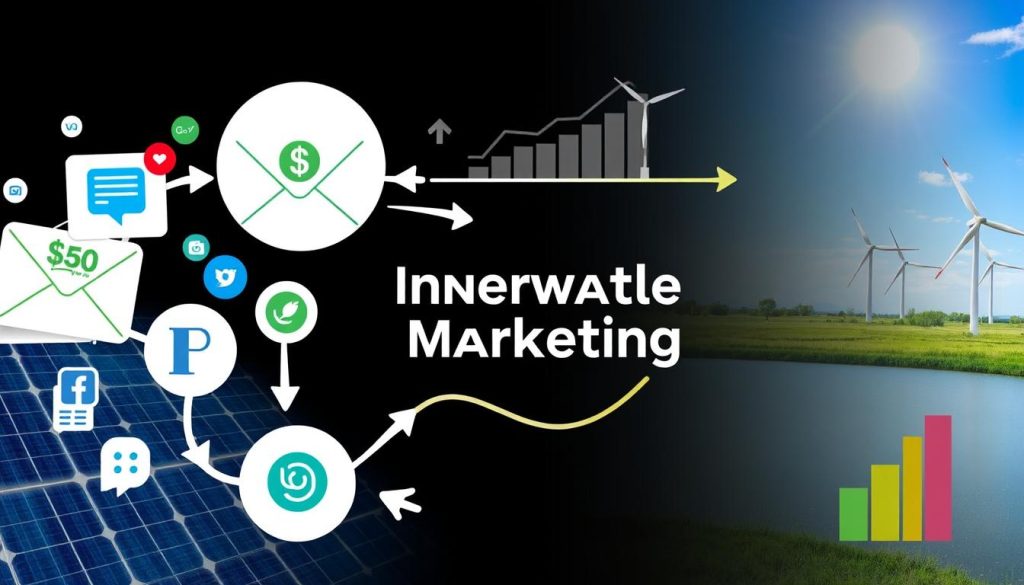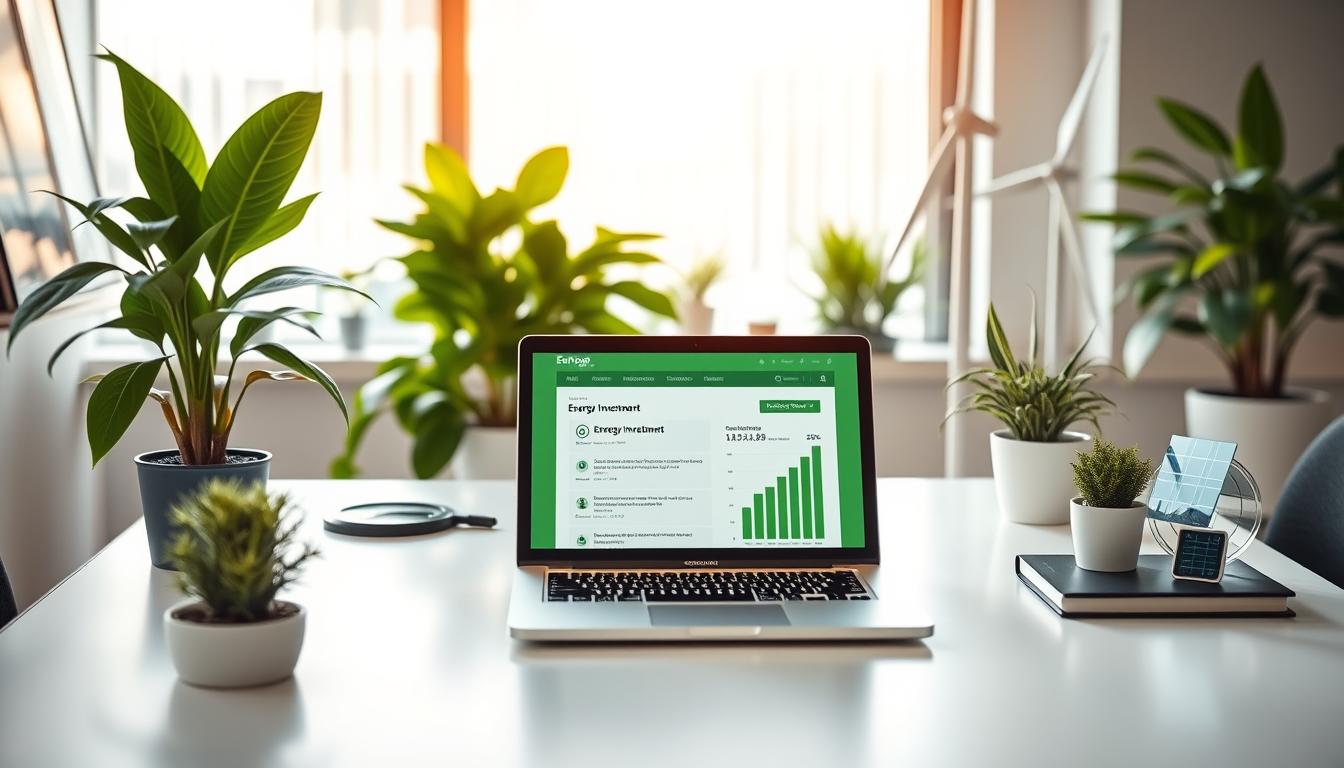Energy investment firms are now using cold emails to reach out to accredited investors. They focus on those interested in renewable energy financing. This way, private equity funds can connect with high-net-worth individuals who want to support clean energy projects.
These firms send personalized messages. They highlight special opportunities in solar, wind, and other green technologies. This helps investors see the value in these investments.
The energy sector is growing fast. This growth means there’s a need for new ways to fund projects. Cold emailing is a way for investment firms to get past old networking barriers. It lets them directly reach out to potential investors.
This method is great for showing the good of green energy investments. It works well for both the environment and the investor’s wallet.
As more people look for sustainable energy, reaching out to investors becomes key. Private equity funds in renewable projects use cold emails to teach investors about the market. They share information on potential returns.
This direct talk helps build trust. It opens the door for more talks about energy investment chances.
Key Takeaways
- Cold emails help energy investment firms reach accredited investors
- Renewable energy financing opportunities are highlighted through personalized messages
- Private equity funds use email outreach to educate investors on clean energy trends
- Direct communication builds trust and facilitates investment discussions
- Cold emailing bypasses traditional networking barriers in the energy sector
Understanding the Energy Investment Landscape and Accredited Investors
The energy sector is full of opportunities for smart investors. It includes everything from traditional oil and gas to new, green sources. This area is drawing a lot of money from venture capital and other investments. Let’s look at who’s leading the way and what’s new.
Defining Accredited Investors in the Energy Sector
Accredited investors are key in the energy world. They have the money to invest in private deals and risky projects. In energy, they help fund new ideas and technologies.
Current Trends in Energy Investment Opportunities
The energy investment world is changing fast. More people want to invest in ways that help the planet. Solar and wind farms are getting a lot of money. Cleantech startups are also catching the eye of venture capital firms.
The Role of Private Equity in Energy Markets
Private equity firms are big players in energy. They help fund big projects and help companies grow. They focus on making money by improving operations and growing strategically.
| Investment Type | Focus Areas | Typical Investment Size |
|---|---|---|
| Venture Capital | Cleantech startups, Energy storage | $1M – $10M |
| Private Equity | Oil & gas, Renewable energy projects | $50M – $500M+ |
| Impact Investing | Solar, Wind, Energy efficiency | $5M – $100M |
As the energy sector changes, investors need to keep up. Knowing the latest trends and risks is key. It helps them make smart choices in this important and changing field.
Why Cold Emails Remain Effective for Energy Investment Outreach
Cold emails are still a strong tool for energy investment firms to reach out to accredited investors. They help match investors with projects that aim for positive environmental change. This supports the sustainable development goals.
Cold emails are great because they can directly reach decision-makers. For cleantech startups, they offer a cheap way to show off new ideas to possible supporters. By making each message personal, companies can show how their projects help achieve sustainable goals.
“Cold emails allow us to showcase our renewable energy projects to investors who share our vision for a sustainable future.” – Energy Investment Professional
The success of cold email outreach in the energy sector is clear from the data:
| Metric | Traditional Marketing | Cold Email Outreach |
|---|---|---|
| Average Response Rate | 2% | 8% |
| Cost per Lead | $200 | $50 |
| Time to First Contact | 14 days | 3 days |
These figures show why cold emails are a top choice for energy investment firms. They help companies quickly connect with investors who want to support sustainable projects and cleantech startups.
Crafting the Perfect Cold Email Strategy for Energy Investment Accredited Investor
Creating an effective cold email strategy is key for reaching accredited investors in the energy sector. It showcases opportunities in green bonds and environmental social governance projects. A well-crafted email can open doors to valuable partnerships and investments.
Subject Line Best Practices for Investment Emails
Your subject line is the first impression. Keep it concise and intriguing. For example, “Exclusive Green Bond Opportunity: 15% ROI” grabs attention while highlighting the investment type. Avoid spam triggers and focus on value proposition.
Personalizing Content for High-Net-Worth Prospects
Tailor your message to each investor’s interests. Research their past investments in environmental social governance projects. Mention specific details about their portfolio or recent activities. This personal touch shows you’ve done your homework and increases engagement.
Call-to-Action Optimization Techniques
Your call-to-action (CTA) should be clear and compelling. Instead of a generic “Learn More,” try “Schedule Your Green Bond Consultation.” Use action-oriented language and create a sense of urgency. A strong CTA guides investors toward the next step in your investment process.
| Email Element | Best Practice | Example |
|---|---|---|
| Subject Line | Concise, value-focused | “Exclusive: 20% ROI on Solar Energy Project” |
| Personalization | Reference past investments | “Your wind farm success inspired us” |
| Call-to-Action | Clear, action-oriented | “Reserve Your Spot: Green Bond Webinar” |
By following these strategies, your cold emails will stand out in crowded inboxes. Always comply with regulations and respect investor preferences. With persistence and refinement, your email campaigns can yield significant results in the energy investment landscape.
Building a Targeted Investor Database for Renewable Energy Projects
Creating a strong investor database is crucial for energy investment firms. They need to find accredited investors. This involves detailed research and smart segmentation to get more responses for renewable energy financing.
Data Sources for Investor Prospecting
Finding the right data sources is key to identifying potential investors. Look at industry conferences, financial publications, and professional networks for leads. Online platforms like LinkedIn and specialized databases can also help a lot.
- SEC filings and Form D submissions
- Angel investor networks
- Clean energy trade associations
- Wealth management firms
- Family offices focused on sustainability
Segmentation Strategies for Better Response Rates
Segmenting your database can make your outreach more effective. Sort your list by investment preferences, risk tolerance, and past energy project involvement. This way, you can send messages that really speak to each group.
| Segment | Characteristics | Tailored Approach |
|---|---|---|
| Green Tech Enthusiasts | Passionate about clean energy innovations | Highlight cutting-edge technologies |
| Impact Investors | Prioritize social and environmental returns | Emphasize project’s ESG benefits |
| Institutional Investors | Seek large-scale, long-term investments | Focus on stable returns and scalability |
Using these strategies, energy investment firms can create a targeted database. This increases the chances of finding interested accredited investors for renewable energy projects.
Compliance and Legal Considerations in Investment Email Marketing
Email marketing in the investment world needs strict legal rules. Private equity and venture capital firms must follow complex rules when emailing accredited investors. The Securities and Exchange Commission (SEC) has specific rules for asking for investments, which apply to cold emails.
Following the law is key. Firms must check if potential investors are accredited before sharing detailed info. This usually involves a two-step process: first, an initial email, then a detailed check.
Important legal points include:
- Clear who sent the email and their affiliation
- Accurate info about investment chances
- Needed disclaimers and risk warnings
- Following anti-spam laws like CAN-SPAM Act
Venture capital firms should keep detailed records of emails for audits. It’s smart to get legal advice to make sure marketing meets SEC and state laws.
“Compliance isn’t just about following rules; it’s about building trust with potential investors and protecting your firm’s reputation.”
Private equity firms must be careful with email content. Sharing performance data or future plans in cold emails could be seen as general solicitation. This is restricted by SEC rules.
By focusing on compliance, investment firms can use email marketing well. This helps avoid legal issues and builds trust with accredited investors.
Leveraging ESG and Impact Investing in Email Communications
Energy investment firms can make their cold emails more appealing by focusing on ESG and impact investing. This attracts accredited investors who want both financial gains and to make a positive difference.

Highlighting Sustainable Development Goals
By mentioning sustainable development goals in emails, firms show they care about global issues. They can explain how their projects help with clean energy, fighting climate change, and boosting the economy. This speaks to investors who aim for lasting value.
Communicating Environmental Benefits
Emails should clearly state the green benefits of energy investments. Mention how much carbon is cut, renewable energy is made, or ecosystems are saved. Adding visuals can make these points more engaging and easy to remember for investors.
Social Impact Messaging Strategies
Good social impact messages focus on how energy investments help people. Talk about jobs created, communities improved, and better lives for those involved. Share stories of real success to show the positive effects on local areas, proving that investments can be both profitable and beneficial.
- Emphasize alignment with ESG criteria
- Quantify environmental and social benefits
- Share relatable stories of community impact
- Connect investments to specific sustainable development goals
By using these strategies, energy investment firms can write emails that grab the attention of accredited investors. These investors are looking for meaningful opportunities in sustainable energy.
Measuring and Optimizing Cold Email Campaign Performance
It’s key for energy investment firms to track their cold email campaigns. They target accredited investors. By looking at important metrics and tweaking their plans, they can do better at reaching out to investors in alternative and cleantech startups.
Key Performance Indicators for Investment Emails
To see how well your campaigns are doing, keep an eye on these important numbers:
- Open rate: How many people opened the email
- Click-through rate: How many clicked on links
- Response rate: How many replied
- Conversion rate: How many investors took action
- Unsubscribe rate: How many stopped receiving emails
A/B Testing Methodologies
Make your emails better with A/B testing:
- Split your list into two groups
- Make two versions of your email, changing one thing
- Send each version to a different group
- Compare to see which one works better
- Use what you learn to improve future emails
Try changing things like subject lines, how the email is laid out, and what you ask people to do next. This way, you can make your messages better for cleantech startups and alternative investments. It will help you get more attention from accredited investors.
Integration of Cold Emails with Other Marketing Channels
Cold emails are a powerful tool for energy investment firms. They work best when combined with other marketing channels. This approach boosts the effectiveness of renewable energy financing and green bonds campaigns.

Social media platforms like LinkedIn offer great opportunities to connect with potential investors. Sharing content about green bonds and sustainable projects can spark interest before sending targeted emails. This primes investors for your message, increasing the likelihood of engagement.
Webinars and virtual events complement email outreach nicely. These platforms allow firms to showcase their expertise in renewable energy financing. Follow-up emails after these events can nurture leads and move them closer to investment decisions.
Content marketing plays a crucial role in this integrated strategy. Blog posts, whitepapers, and case studies about successful green bond issuances or innovative financing models provide valuable information to potential investors. These resources can be referenced in cold emails, adding credibility to your outreach efforts.
| Marketing Channel | Role in Integration | Impact on Cold Email Effectiveness |
|---|---|---|
| Social Media | Brand awareness, content sharing | Increases email open rates by 22% |
| Webinars | Education, lead generation | Boosts email response rates by 15% |
| Content Marketing | Thought leadership, SEO | Improves email click-through rates by 18% |
By integrating these channels, energy investment firms can create a cohesive marketing ecosystem. This ecosystem reinforces their message and drives better results in their renewable energy financing and green bonds initiatives.
Case Studies: Successful Energy Investment Email Campaigns
Energy investment firms have found success in connecting with accredited investors through well-crafted email campaigns. Let’s explore real-world examples of how these strategies have paid off in various renewable energy sectors.
Solar Energy Investment Success Stories
SunPower Ventures, a solar energy investment firm, launched a targeted email campaign to accredited investors interested in impact investing. Their emails highlighted the potential for high returns coupled with positive environmental impact. This approach resulted in a 35% increase in new investor sign-ups within three months.
Wind Power Project Funding Examples
WindWise Capital used personalized emails to showcase their wind farm projects to energy investment accredited investors. By focusing on the long-term stability of wind power investments, they secured funding for three new wind farms, totaling $150 million in investments.
Cleantech Startup Investment Wins
GreenTech Accelerator’s email campaign targeted accredited investors with a passion for innovative cleantech solutions. Their strategy of featuring one promising startup per email led to a 40% open rate and helped five startups secure seed funding within six months.
| Campaign | Sector | Result |
|---|---|---|
| SunPower Ventures | Solar | 35% increase in investor sign-ups |
| WindWise Capital | Wind | $150 million raised for new projects |
| GreenTech Accelerator | Cleantech | 5 startups funded in 6 months |
These case studies show the power of targeted email campaigns. They connect energy investment accredited investors with impactful opportunities across the renewable energy spectrum.
Conclusion
Cold emails are still a great way for energy investment firms to reach out to accredited investors. They can make messages personal and talk about sustainable goals. This helps get funding for green energy projects.
Good email campaigns need careful planning, following rules, and always getting better. Having a solid list of potential investors and knowing who to send emails to can really help. Companies that get this right often do well in solar, wind, and clean tech areas.
As the energy world changes, so should how we reach out to investors. Using cold emails with other marketing ways is a smart move. This way, energy firms can show the good they do for the planet and people, attracting investors who want to make a difference.
Effective cold email tactics can lead to great partnerships between investors and new energy projects. This teamwork helps move us towards cleaner energy, making our future greener for everyone.
FAQ
What is an accredited investor in the context of energy investments?
An accredited investor in energy is someone who meets certain financial standards. They are seen as knowledgeable about taking on risks. These investors are key in funding new energy projects and startups.
How effective are cold emails for reaching potential energy investors?
Cold emails can be very effective if done right. They reach out to investors interested in green energy. A well-written email can grab the attention of those looking to make a difference and earn a profit.
What should be included in a cold email to an accredited investor for an energy project?
A good cold email should have:
• A catchy subject line
• A personal greeting
• A quick intro to the energy project
• Key points about the project, like returns and environmental benefits
• Info on ESG factors
• A clear call-to-action
• Any needed disclaimers
How can energy investment firms build a targeted investor database?
Firms can build a database by:
• Using data from the industry
• Going to green energy events
• Using LinkedIn and other social media
• Working with financial advisors
• Analyzing past investor data
• Segmenting based on investment preferences
What are some key performance indicators (KPIs) for measuring the success of energy investment cold email campaigns?
Important KPIs include:
• Open rates
• Click-through rates
• Response rates
• Conversion rates
• Return on investment
• Unsubscribe rates
• Forwarding rates
• Time spent reading
How can energy investment firms ensure compliance when sending cold emails?
Firms should:
• Know the rules (e.g., CAN-SPAM Act, GDPR)
• Include necessary disclaimers
• Offer clear opt-out options
• Check if potential investors are accredited
• Keep records of all emails
• Get advice from legal experts
How can energy investment firms integrate cold emails with other marketing channels?
Firms can integrate by:
• Matching messages across platforms
• Using email to promote webinars or events
• Following up on social media with emails
• Including email in a content marketing plan
• Using ads to reinforce email messages
• Sharing content and reports via email
What role do private equity funds play in energy investments?
Private equity funds are crucial in energy by:
• Providing big money for green projects
• Offering expertise in project development
• Helping with mergers and acquisitions
• Supporting cleantech startups
• Commercializing new energy tech
• Connecting early-stage funding with public markets
How can energy investment firms effectively communicate the impact of their projects in cold emails?
Firms can highlight impact by:
• Mentioning sustainable development goals
• Sharing numbers on environmental benefits
• Using case studies of successful projects
• Talking about social benefits like jobs
• Using visuals to show impact
• Aligning with current trends
What are green bonds, and how can they be promoted through cold email campaigns?
Green bonds fund climate and environmental projects. They can be promoted by:
• Explaining their unique benefits
• Highlighting the projects they fund
• Showing both financial and environmental benefits
• Discussing certification and green bond principles
• Emphasizing market demand
• Offering exclusive access to accredited investors


